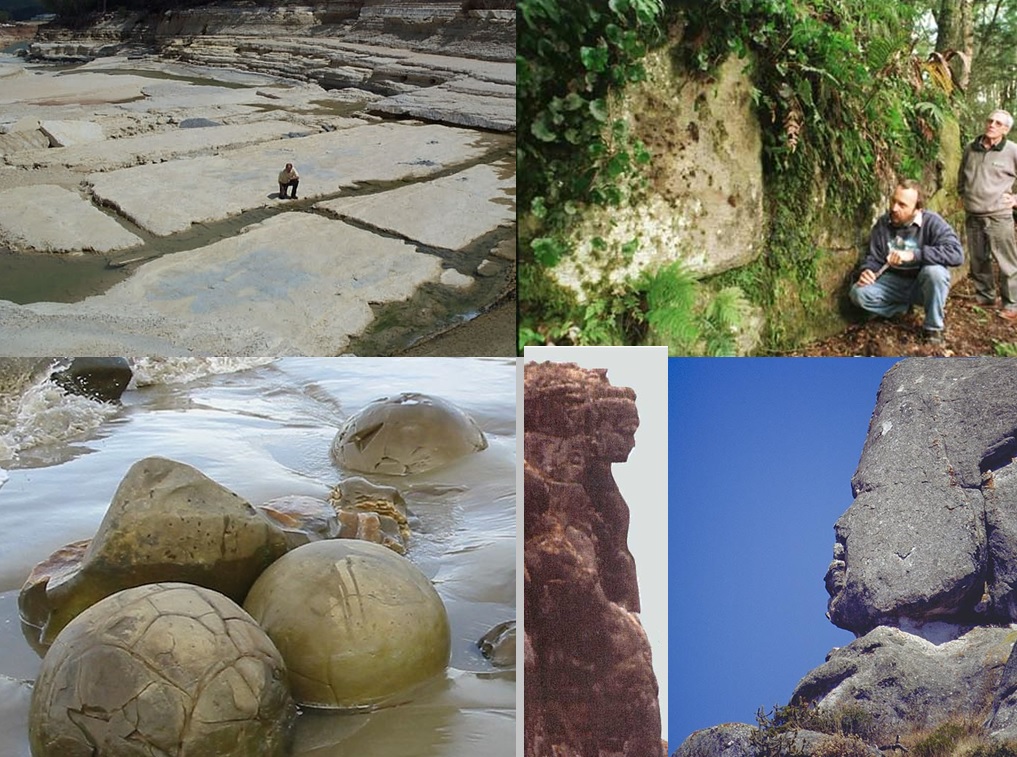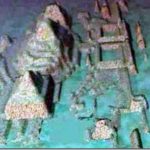 Every few years, Atlantis pops up again, though not in the way Edgar Cayce predicted it would. That is, it does not rise again above the waves; it pops up in news and documentaries and on publishers’ booklists, because somebody or other has yet again discovered exactly where its ruins lie, exactly matching the information in Timaeus and Critias. Plato’s meagre description of Atlantis is apparently some sort of Rorschach inkblot.
Every few years, Atlantis pops up again, though not in the way Edgar Cayce predicted it would. That is, it does not rise again above the waves; it pops up in news and documentaries and on publishers’ booklists, because somebody or other has yet again discovered exactly where its ruins lie, exactly matching the information in Timaeus and Critias. Plato’s meagre description of Atlantis is apparently some sort of Rorschach inkblot.
Though the world known to Plato was limited to the fringes of the Mediterranean Sea, the candidates for Atlantis (and its entirely specious offspring Mu and Lemuria) range across the entire globe. Sometimes some topographical feature is deemed to match Plato’s description of the city; sometimes there is the appearance of cyclopean masonry or other manmade structures on the seabed. The indefatigable Atlantipedia lists 654 geographical opinions expressed over the centuries on the location of the lost continent (excluding those from psychics and theosophists), of which 224 date from the 21st century alone. [Note: Atlantipedia experiences periodic difficulties, such that the links frequently fail. Still, it is well worth a look when it’s up and running.]
But one thriving subcult of pseudoarchaeology welcomes this wild proliferation of proposals. It seems an advanced global civilization was destroyed about 10,000 BC (Edgar Cayce’s date) as the last Ice Age was ending, but left coded traces of its wisdom and glories in the monuments of later eras. Even better, it hid its actual documents in at least three mysterious “Halls of Records,” one of which Cayce predicted would be found between the paws of the Sphinx in Giza before the end of the 20th century. Overall, the scenario builds on a reworking of Ignatius Donnelly’s long-debunked Atlantis theories, often with a sprinkling of ancient aliens on top. Like most pseudoscience, it seethes with a virulent hostility to academic archaeology, which it describes as a hidebound orthodoxy and a conspiracy to hide “the truth.”
At any rate, these theorists happily embrace numerous competing Atlantis proposals by co-opting them as yet more evidence of the Lost Civilization, outlying cities in Atlantis’s global maritime empire. Indeed, they have never met an Atlantis they didn’t like. Here is a partial list:
Andalusia, Antarctica, the Arabian peninsula, the Azores, the Sea of Azov in Turkey, the Bahamas, the Baltic Sea, the Bermuda Triangle, the Black Sea, Bolivia, Bosnia, the Gulf of Cambay, the Canary Islands, Lake Copais in Boetia, Cornwall offshore, Cuba offshore, Cyprus offshore, Le Danois Bank in Spain, coastal Denmark, the Dogger Bank, Helike in Greece, Indonesia, the Irish Sea, Mount Kilimanjaro, Malta, Morocco, Nandol, the North Pole, Peru, Pharos off Alexandria, Ponza near Naples, the Sahara, Sardinia, Sicily, South America in general, the Spartel Bank off Gibraltar, Tampa in Florida, Tantalus in Turkey, Thera, Troy, Uppsala, and Yonaguni off Japan. For starters.
Clearly one cannot cover all the candidates in anything less than book-length, but many of them fall into convenient categories. One common factor is a kind of pareidolia (the tendency to see patterns in random input), which is especially influential in the misinterpretation of geological formations, sonar data, and the archaeological record. National pride and wishful thinking are also powerful motivators. In a smaller category are sites that actually have some plausibility going for them. We’ll start with the hopeless categories, and then end the series with a few genuine archaeological possibilities.
MISINTERPRETATION OF NATURAL FEATURES
This is a major category. Contrary to popular belief, Nature is almost better at making large-scale masonry than humans are, producing fabulous geological formations that look for all the world like pyramids, artifacts, or Lovecraft-style primeval ruins. Add a dash of pareidolia, and you have the recipe for any number of Atlantis/Lost Civilization sites. The pictures below are all natural features.
The “Bimini Road,” off the shore of Bimini Island in the Bahamas, is a classic example. Edgar Cayce predicted Atlantis would rise above the waves off Bimini in 1968 or 1969, and it obviously did not; but some members of his Association for Research and Enlightenment went to the island in 1968, found this feature, and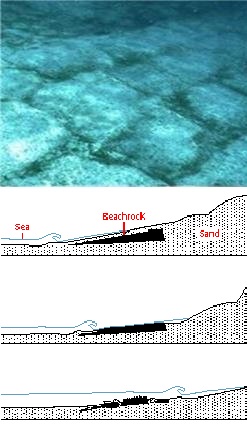 decided the prophecy had been fulfilled after all, though the “ruins” in question continued to lie stubbornly under 18’ of water.
decided the prophecy had been fulfilled after all, though the “ruins” in question continued to lie stubbornly under 18’ of water.
The Bimini “ruins” resemble cyclopean masonry on the seabed, not far offshore: large, rectilinear blocks or pavers, arranged in a line about half a mile long, curving into a J at one end. Geologists identify it as a fairly common formation called beachrock, a natural limestone pavement that forms rapidly along the tideline under certain conditions, and tends to fracture along straight lines. C14 dating on shells within the limestone matrix at Bimini gave dates of about 2000 to 4000 years old, far too young for Atlantis or the Lost Civilization. End of story for the geologists. Archaeologists don’t really consider Bimini an archaeological problem at all, except when people ask them about it at parties. Nevertheless, it continues to be regarded as prime Atlantis real estate in certain quarters.
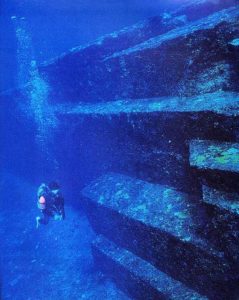 The “Yonaguni Monument” is another classic. A couple of hundred metres off the shore of Yonaguni, the southernmost island of Japan, the “Monument” is a sizable rock formation within diving distance of the surface. It bears a superficial resemblance to a city tell or a fortress, but it is essentially one big rock—a very large lump of sandstone displaying normal fracturing along bedding planes and parallel joints, to produce sharp-edged steps and flat surfaces that, with the help of wishful thinking, have been interpreted as architectural.
The “Yonaguni Monument” is another classic. A couple of hundred metres off the shore of Yonaguni, the southernmost island of Japan, the “Monument” is a sizable rock formation within diving distance of the surface. It bears a superficial resemblance to a city tell or a fortress, but it is essentially one big rock—a very large lump of sandstone displaying normal fracturing along bedding planes and parallel joints, to produce sharp-edged steps and flat surfaces that, with the help of wishful thinking, have been interpreted as architectural.
Yonaguni’s great champion is seismologist Prof. Masaaki Kimura, who regards the rock as a relic of the lost continent of Mu, built or at least terraformed by human hands before the post-glacial waters rose. (He seems to be unaware of the 19th-century origin of Mu in a bogus translation of a Mayan codex.) In the planes and steps of Yonaguni, he has identified many manmade wonders: roads, a gate, a pyramid, plazas, megalithic sculptures, a pool, a stadium, castles, a “holy place,” and pictographs. Alas, the sculptures and pictographs are masterpieces of pareidolia; the architectural wonders make no sense, like the alien-angled chthonic cities of the Cthulu Mythos.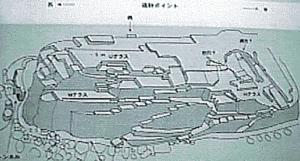
Note: there are no actual structures, rooms, or convincing artifacts associated with the “Monument.” No archaeological remains on the island are older than about 2500 years. The most astonishing thing about Yonaguni is that a presumably competent marine seismologist cannot be reasoned out of a passionate belief in his thoroughly unconvincing “lost city.”
Then there’s Gunung Padang in West Java, about which I have already written extensively—another site where a prefessional seismologist, Dr. Danny Hilman Natawidjaja, has let his imagination (and possibly his nationalism) run away with him. (I have spend a great deal of time over the last year critiquing his claims for Gunung Padang, and will not repeat myself here; anyone interested can look at my blog archives.)
 Natawidjaja was not the first to propose Indonesia as the site of ancient Atlantis. It is highly likely he was inspired by the late Prof. Arysio Nunes dos Santos, a Brazilian engineer, whose book Atlantis: The Lost Continent Finally Found became a hit in Indonesia, where he placed Atlantis. The book is a wild mishmash of junk linguistics, pseudohistory, bad geology, idiosyncratic interpretations of texts, and mysticism; Natawidjaja rightly rejected the geology as nonsense but swallowed all the rest. Indeed, Natawidjaja wrote a book of his own, entitled Plato Never Lied: Atlantis is in Indonesia, making the case that the now-submerged portions of the Indonesian archipelago exactly match Plato’s description of Atlantis. Unfortunately, many of his “exact” matches actually refer to Athens rather than Atlantis in Plato’s work, and the rest is bog-standard pseudoarchaeology.
Natawidjaja was not the first to propose Indonesia as the site of ancient Atlantis. It is highly likely he was inspired by the late Prof. Arysio Nunes dos Santos, a Brazilian engineer, whose book Atlantis: The Lost Continent Finally Found became a hit in Indonesia, where he placed Atlantis. The book is a wild mishmash of junk linguistics, pseudohistory, bad geology, idiosyncratic interpretations of texts, and mysticism; Natawidjaja rightly rejected the geology as nonsense but swallowed all the rest. Indeed, Natawidjaja wrote a book of his own, entitled Plato Never Lied: Atlantis is in Indonesia, making the case that the now-submerged portions of the Indonesian archipelago exactly match Plato’s description of Atlantis. Unfortunately, many of his “exact” matches actually refer to Athens rather than Atlantis in Plato’s work, and the rest is bog-standard pseudoarchaeology.
 Naturally, the Lost Civilization cult embraces both Yonaguni and Gunung Padang as genuine, just as they do the so-called “pyramids” in Visoko, Bosnia. Graham Hancock, high priest of the Lost Civ cult, even hopes that a Cayce-type Hall of Records will be found in Gunung Padang’s lava chambers once a way is opened. But there is an interesting conflict in their agendas that is rarely recognized. When someone like Danny Hilman Natawidjaja finds Atlantean wonders on his home ground, he implicitly attributes them to his national ancestors; but the proponents of the Lost Civilization explicitly envision a white super-race, whose survivors fanned out as culture-bearers to the benighted natives across the world after their advanced Ice Age Atlantis was destroyed.
Naturally, the Lost Civilization cult embraces both Yonaguni and Gunung Padang as genuine, just as they do the so-called “pyramids” in Visoko, Bosnia. Graham Hancock, high priest of the Lost Civ cult, even hopes that a Cayce-type Hall of Records will be found in Gunung Padang’s lava chambers once a way is opened. But there is an interesting conflict in their agendas that is rarely recognized. When someone like Danny Hilman Natawidjaja finds Atlantean wonders on his home ground, he implicitly attributes them to his national ancestors; but the proponents of the Lost Civilization explicitly envision a white super-race, whose survivors fanned out as culture-bearers to the benighted natives across the world after their advanced Ice Age Atlantis was destroyed.
Meantime, Gunung Padang is still a hill, and the Yonaguni Monument is still a rock.
NEXT: Sonar and So Forth

